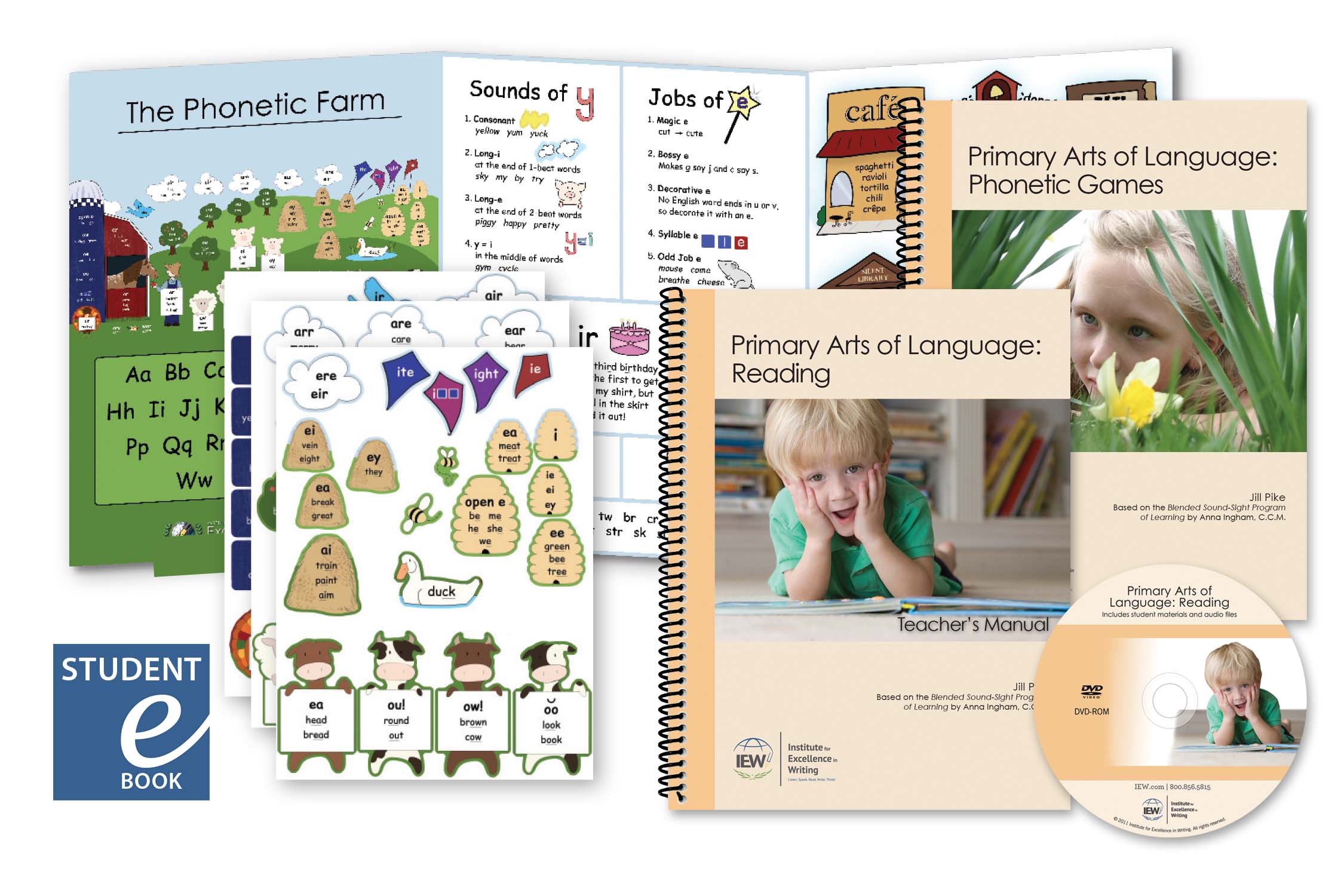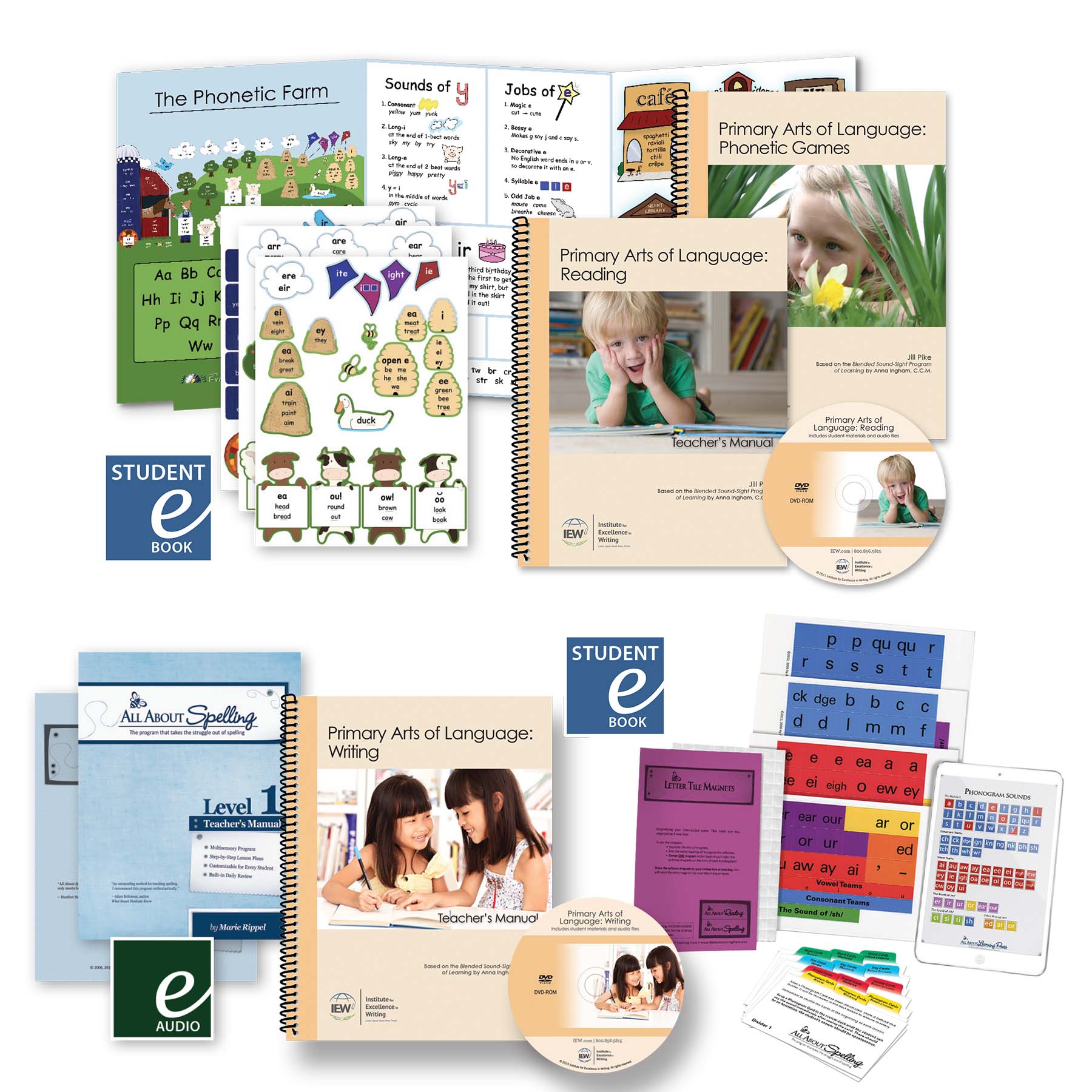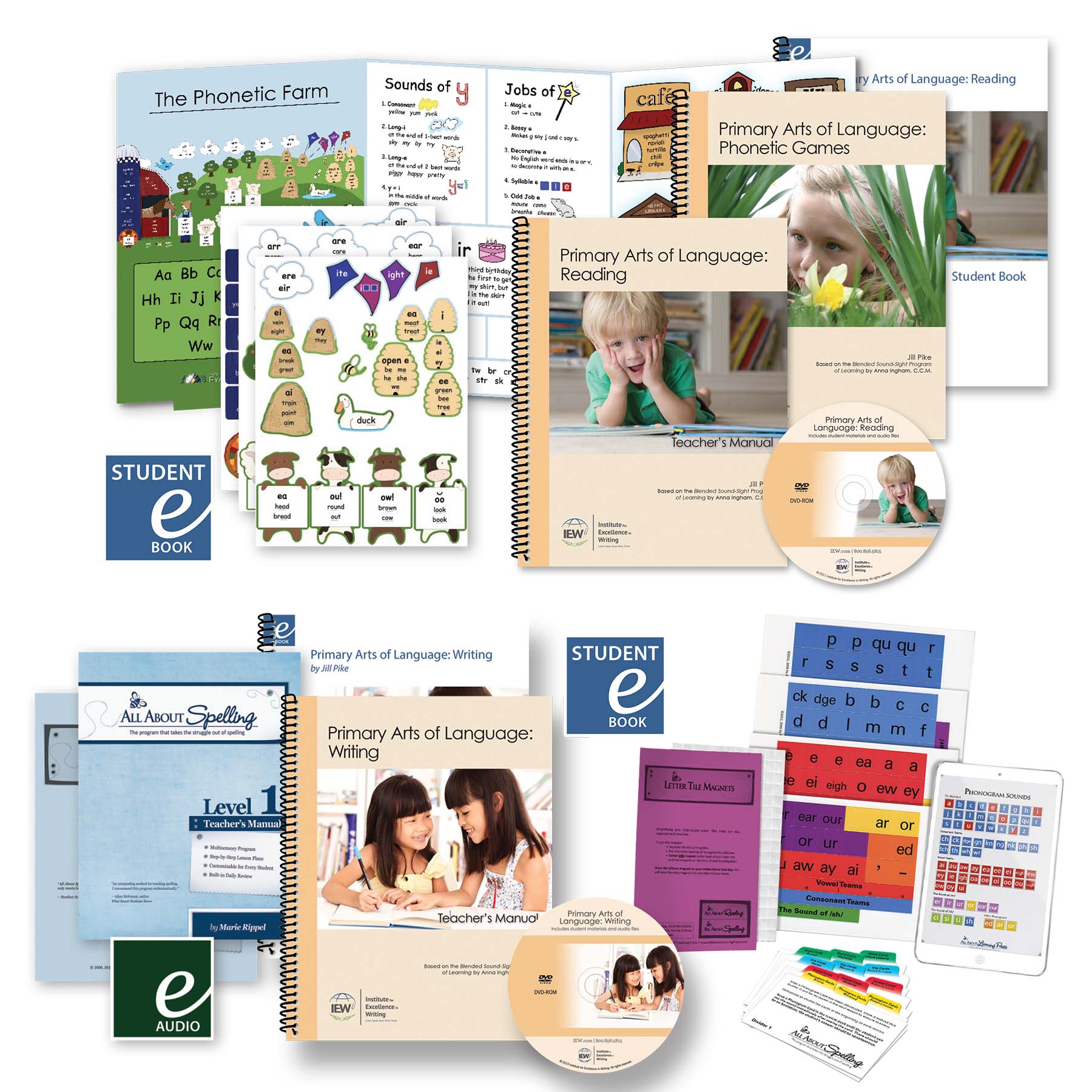Primary Arts of Language: Writing Complete Package

|
The writing portion of Primary Arts of Language, which is divided into three parts: printing, copy work, and composition, should be used concurrently with the reading portion unless your child is already reading. Then you can use these lessons independently. Spelling is included throughout the course. The printing section provides an entire handwriting program to teach your student how to correctly form his letters—he will learn his letter sounds as he learns to write them. |
Watch Videos/Excerpts
|
The copy work exercises will make printing automatic in preparation for the composition lessons, which will gently teach your student to write stories and paragraphs with style.
This package includes:
- Primary Arts of Language: Writing Teacher’s Manual
- Primary Arts of Language: Writing DVD-ROM
Includes the following:- Instructional Video by Jill Pike
- Six MP3 audio talks:
- Reading Comprehension from Seuss to Socrates by Adam Andrews
- Dictation, Narration, and Public Speaking by Andrew Pudewa
- The Four Language Arts by Andrew Pudewa
- Units I/II in the K–2 Classroom by Shirley George
- Unit III in the K–2 Environment by Shirley George
- The K–2 Writing Environment by Richelle Palmer
- Primary Arts of Language: Writing Student Books (e-book)
(Would you rather have us print out your PAL student e-books for you? Click here.)
- All About Spelling Basic Interactive Kit
- All About Spelling Level 1 (Teacher’s Manual and One Student Material Packet) by Marie Rippel
Cost if purchased separately: $97
ISBN: 978-1-62341-058-2
Copyright Date: January 2011
Copyright:
PAL Writing: Teacher's Manual Sample.pdf
Sample pages from the Writing Teacher’s Manual. The scope and sequence for the course is at the end of the sample.
PAL Writing: Student e-book Sample.pdf
Several pages from the reproducible student book.
I absolutely LOVE the PAL Reading and Writing. I am using it for my 6-year-old, who has sensory processing disorder. The structure and hands-on method has changed everything for him. Bless you all.
-Nanci
I felt a little awed by the complete PAL program when I first got it. The good news is it's easy once you get into it.
1. VIDEO INTRO: What I did first was watch the videos...just popping the DVD into my computer automatically started the video. The reading & writing DVDs both have great explanations. Really, I watched the overview a couple of times because I wanted to take some notes on some things that Jill said. For example, if a kid is reading "Little Bear" books, start in Part 2 of the Writing program. But, overall, the videos give you a feel for it all and are a great overview.
2. TEACHER'S MANUALS: Then, I looked briefly through the teacher's manuals and the corresponding student pages for several of the lessons. After looking through a few of the lessons on each part I realized how well organized the lessons were and I gained confidence in using and trusting the plan! This also helped me decide where to start with my kids.
3. STUDENT MATERIALS: Then, I printed copies of the student materials for each of my students...at least the part they would be starting on. Remember that the reading materials need to be single sided because the student cuts on a lot of the pages.
4. GAMES: I made about a dozen of the first games because I'm on a short time schedule for these lessons in my coop. Many people just do this with their kids. I also looked over the Phonetic Farm (and noticed that the "completed" farm is pictured on the front of the folder...so you know where to put the stickers!)
5. DIVE IN! Just starting the first lessons was the best day. We're doing the reading and writing together. It flows so nicely. I usually glance over the lesson over coffee in the morning and then follow it (the book) with the kids. We do a lesson one day and follow up with games/practice the next day. Most weeks are two lessons, some have been one.
I hope these ideas help!
Jenn
My daughter just completed Lesson 55 in PAL. She recently brought me the book Green Eggs and Ham and asked me to read it to her. I told her I would, but that I thought she could probably read it herself. She replied, "Oh, no, mommy, I can't read." So I asked her to read the title. She did. Her eyes got absolutely huge. Then she read the first page, and the next, and the next. With each succeeding page, her eyes got bigger. By the fourth page, the look of astonishment on her face was unsurpassed. She turned to me and said, "Mommy! I can read!" (Can I just tell you I almost cried? She is almost 8, with learning issues, and I was beginning to wonder if we would ever get there!)
-Michelle
I received PAL last week and have had such fun pouring over it. I have a 4-year-old and 6-year-old who are having such fun with it! We did the first lessons today and created the first three games. The games are working already as they reinforce what they've learned. What a wonderful resource!
As I watched Jill's instruction DVDs and listened to Anna Ingham, I was struck by how much this all would have helped me as a first-year teacher. Between TWSS and PAL, we have a complete Language Arts methods class that would probably be equivalent to at least two 3 credit classes in college—probably more. When I graduated (with highest honors) with a degree in English and Elementary Education, I still had no idea how to teach a child to read or write. And this was from a conservative private college. We just didn't have anything this practical or usable in terms of principles and concepts of education. When I began homeschooling my kids, I had to buy materials to teach them to read. After spending thousands to learn to be a teacher. There is something wrong with this picture! I wish we could somehow communicate this to parents whose children are considering education as a career field. These two products would make wonderful graduation gifts!
-Danielle
Oh yes.....we can relate to your enthusiasm! And we can relate to your child's excitement and enthusiasm for beginning! Which leads me to a friendly warning...
IF you've ordered PAL and IF you don't plan to begin as soon as your materials arrive, you need to find a secluded, private place in your home to examine and peruse your new materials. DO NOT open the Phonetic Farm in front of your children if you don't plan on using it right away! That Farm and all the stickers are just TOO enticing for young eyes to wait!
I had planned on waiting until fall to begin PAL at our home...but we are now on Lesson 4 :). I am not exaggerating when I say that my son begs me multiple times DAILY to work on his PAL program. In fact yesterday (Saturday) his father warned him that if he asked one more time that day he would not be allowed to do it, and would have to wait until Monday. So he stood as a sentry, eyeing our "box" of materials, until I made time for him :).
I only share from my own experience.....be warned!
Warmly (with humor, but truth!),
Carrie in AL
I'm using the PAL program with my 3rd grade daughter who is severely dyslexic. We only started 5 days ago, but everything just suddenly makes sense for her!
Each Wednesday night we meet with 5 other families for a meal and informal Bible study. With all the kids there, it adds up to about 40 people—yes the kids outnumber the adults! The children sit on the floor near their parents and we talk about the Bible for about 2 hours. It is the highlight of our week. My kids know to bring coloring books, drawing paper, or other quiet amusements so they can be occupied while listening.
I've been putting the work pages from PAL on a clipboard for my two littles, so they can find them easily during the Agenda time. Yesterday my 6-year-old asked if she could bring the worksheets with her. She happily filled out the writing pages and did the cutting/pasting activity. Then she turned to the sheet of lyrics we had sung at the start of the study. It contained 4 verses of the hymn, See What a Morning, by Keith and Kristine Getty. At the end of the study, she handed it to me and grinned. She had marked every helper, short vowel, magic-e, and anything else she could find that we had learned!
Every other phonics program I've tried has suggested "look for more examples of --- sound/phonogram/letter" or "later today, review the sounds with your child." With PAL, my kids are having so much fun, they hear the examples in everything else we read, they are looking for the helpers in most of the books we read, and they are practicing without any encouragement from me.
Thank you for this product! I'm selling all my old phonics materials (and believe me, the shelf was groaning with so many different things!) I only wish this had been out 7 years ago so I could have used it with my older two. Now I only have 3 more to use it. Oh well, I guess I'll just have to wait for the grandkids!
-Danielle in MI
I just had to take a moment this morning to share a funny scenario that occurred in our home yesterday.....
I have been working with my 4.5-year-old son for the last few weeks on PAL Reading and Writing. (I could write a mini-book about how wonderful this has been for us!!!!). Although I've been focusing mainly on teaching to this particular child, other siblings have, of course, caught "PAL-fever" and listened along as we learn and play through PAL on the living room floor each day. At times my newly 3-year-old daughter will hang around and play with her dolls or put the bones in MUG'S mouth, but rarely actually "participates."
Yesterday, this dear daughter was using the bathroom, waiting for me to come and well, wipe her up :). She urgently called "Mom, Mom...come here!". As I did, she excitedly showed me the tag in her pajama pants. She was wearing a pair of pants (way too big for her!) that were size "6". From her viewpoint, the "6" was upside down. She pointed to the tag and exclaimed, "Look Mom! I have the draggy-leg letter!!!" She was so immensely proud of the fact that her tag looked like it had the letter "g" on it!
I hugged her as hard as I could (without hurting her!) and tried to share my excitement through my giggly delight. I was blown away! She had been listening all along and actually "getting it", and I had no clue. And that she would recognize this on her own is just so exciting to me. Thought some of you ladies could appreciate my excitement :)
P.S. We have a semi-large, blank wall in our main bathroom, which the younger children use on a regular basis. I have been thinking of purchasing some larger-sized alphabet cards to put on the walls there so that we could utilize the time spent in the bathroom more efficiently and learn our letter sounds at the same time :). Instead of purchasing these, I think I'm going to print the individual "letter story cards" from PAL on cardstock, color them in, laminate, and put them up. I thought it would make a useful, colorful wall decoration and integrate our reading/writing curriculum with other "daily" tasks :).
-Carrie in AL



